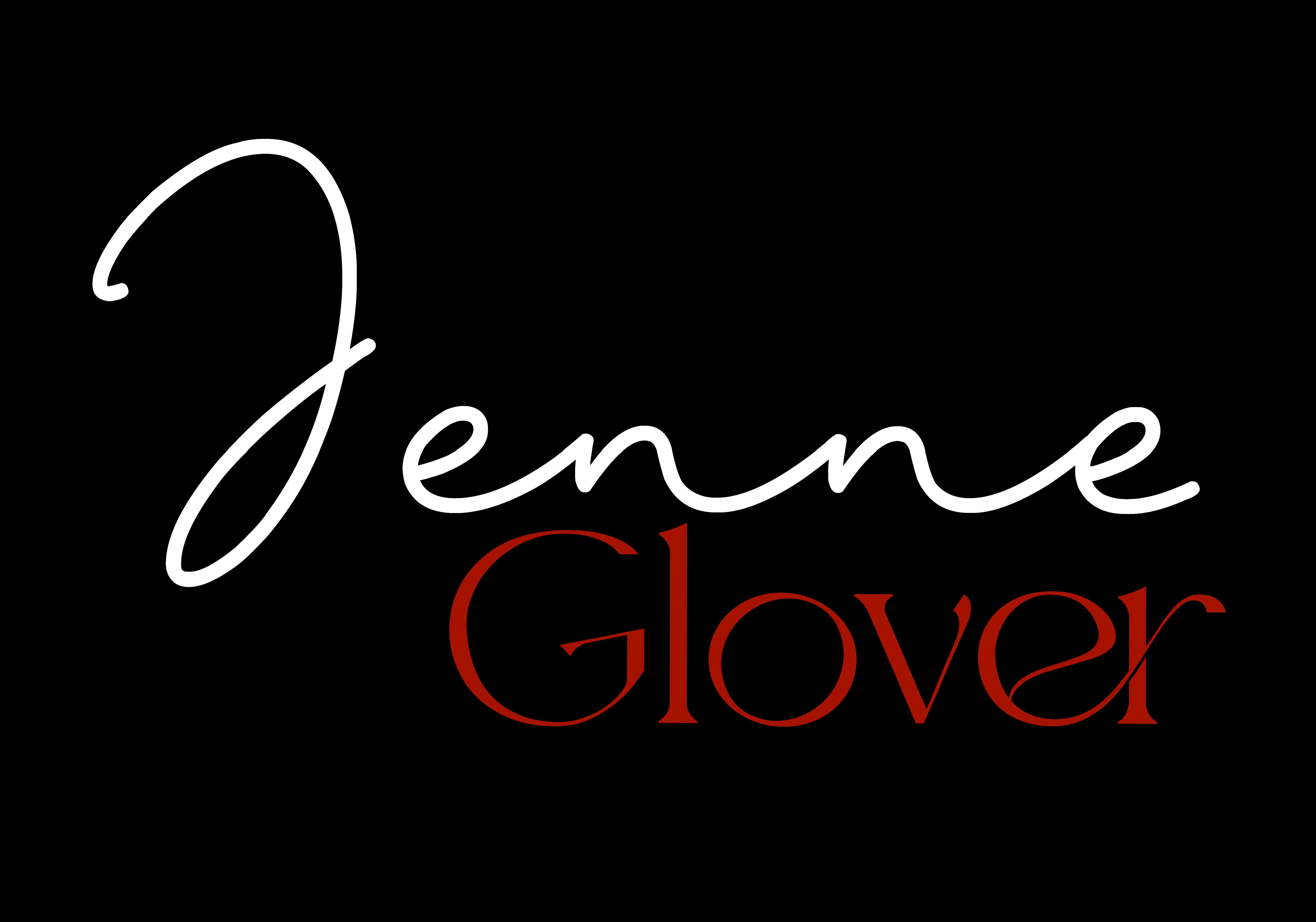• Editor’s Perspective: Ken Burns – The National Parks: America’s Best Idea
• Contemporary Artist: The Art of Joseph Holston, Part 2 — Destined for Greatness
• Paul Goodnight @ Gallery Serengeti
Meet the Artist, December 5, 2009 3:00 p.m. to 5:00 p.m.
December 5, 2009 to January 11, 2010
7919 Central Avenue, Capitol Heights, MD 20743
301-808-6987
• Got Art? @ Design Studio Art Gallery
Opening Reception — Sunday, November 15, 2009
6:00 p.m. to 9:00 p.m.
November 8, 2009 – December 27, 2009
5702 Baltimore Avenue
Hyattsville, MD 20781
301-779-4907; 202-446-7373
• Next Issue: Paul Goodnight
Editor’s Perspective: Ken Burns – The National Parks: America’s Best Idea
Living in the city, it’s easy to forget there are places in America that are free of commercialism, pollution, and urban life chaos. The National Parks: America’s Best Idea, is a 6-episode series on the history of the National Parks, from 1851 to 1980.
Directed by Ken Burns and written and co-produced by Dayton Duncan, the film transports you to some of the beautiful natural wonders existing within our borders. The film tells the story of the pioneers who supported a radical idea of preserving and protecting America’s significant landscapes for all Americans. It examines the challenges made by capitalists set on commercial use of the land and gives the perspective of Tribal Nations displaced in the process.
The National Parks: America’s Best Idea, features some of nature’s most spectacular locations including the Everglades, Acadia, the Grand Canyon, Yellowstone, Yosemite, and the Gates of the Arctic. Visually stunning, it is rejuvenating to see Mother Nature’s majestic power, even from afar.
Click here to order the series.

Contemporary Artist: The Art of Joseph Holston, Part 2 — Destined for Greatness
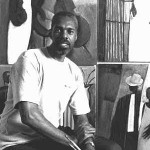
Joseph’s life as an artist seems to have unfolded in a natural progression of events. He began developing his skills as a four-year-old, copying his mother’s art, as she learned how to draw through books and correspondence schools. Very much a loner and a dreamer, Joseph found himself always creating visual stories in his head. And, being the fifth child of six and having four older and bossy sisters, finding a quiet place to draw provided him peace and refuge. In school he always felt disconnected and unfocused, and recalls being reprimanded often for his daydreaming.
When Joseph was 17, he moved from Chevy Chase to Washington, D.C. A chance encounter with Ronald Wildy, an advertising art student, who was attending Chamberlain Vocational High School, was a changing point in his life. Although his mom wanted him to finish regular high school and get a job, Joseph secretly took the entrance test for commercial art at Chamberlain. Mr. Washburn, the art teacher, suggested that he wait until next year to enroll, but Joseph persuaded Washburn to register him for the upcoming school year. Once accepted, his mother acquiesced and Joseph received formal training in commercial art.
Upon graduation, he worked as a commercial artist for Sears & Roebuck, the Hecht Company, and with various consulting firms and art agencies around town. He enjoyed the work because it provided him the opportunity to use his creativity, to master various mediums, develop different products, work with customers, and make deadlines. But after doing this for eight years, he knew he had a deep desire to be a fine artist, specifically a portrait painter.
Joseph frequently took art courses after work and while researching for an instructor in portrait painting, ventured off to Santa Fe, New Mexico to study with Richard Goetz, who had turned to teaching impressionism. Goetz advised Joseph to rethink his plan to become a portrait painter because it was limiting and would strip him of his creativity. He advised Joseph to capitalize on his abilities. Joseph could only afford to stay away from his regular job for three weeks, but the time spent painting on location solidified his conviction to be a fine art painter.
When he returned to D.C., he didn’t know how he was going to support himself. However, he did know he would have to be resourceful when it came to creating and showing his work, in order to build a client base. Joseph took Goetz advice and began doing figurative art, hiring models to sketch. His well-known piece, “Boy in Red Cap” came out of this period. In developing this work, Joseph’s goal was to isolate the observer in a one-on-one interaction with the subject, which he achieved by painting the boy with one eye peering directly at you from under a cocked cap.
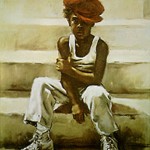
Boy in Red Cap, 1972
Joseph Holston
Oil on Canvas 40×32
During this period he also began building a collection of work, which he exhibited and sold in the Art on the Mall program sponsored by the National Park Service. These weekly shows on the National Mall, as well as other shows at numerous locations, including Malcolm X Park, were inspirational because they provided him with a sound gauge on the pulse of his market. And remarkably, many of the individuals who purchased his early paintings are patrons to this day. Yet, making money is not what drives Joseph; he’s motivated by the response his work evokes, and feels humbled that people want to own his creations.
Joseph credits his commercial art training for preparing him for the business side of art…marketing and selling his work. There were bumps along the way, but he always knew he had to work hard and pay attention to his patrons. He worked confidently knowing that something positive was around the corner and that doors would eventually open for him. And, although Joseph knew he could always return to the commercial art world, he proudly notes that 40 years later, he has developed a rewarding fine art career and has never looked back. He notes that many artists want to use only one side of their brain and they don’t want to think about the business side. He emphasizes that most artists can’t rely solely on galleries to survive; they must know something about marketing their work, how to open doors of opportunity, how to stay visible, build a client base, and keep their patrons informed.
Joseph says his art career can be divided into two phases. During the first phase, his work was representational, with nature as its foundation. The second phase emerged after finding his spiritual voice; by digging deeper to remain fresh and exploring more creative ways of expressing a concept. Moreover, he’s always striving to do something better, like finding a stronger palette, or innovative ways of bringing his paintings to life.
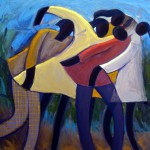
Rhythm ‘N’ Play
Joseph Holston
Mixed Media 48X48
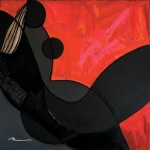
Nude in Evening
Joseph Holston
Mixed Media 36″x36″
Along with his paintings, Joseph’s etchings are celebrated all over the world. He began mastering this medium in 1974, at a printmaking workshop he attended at Howard University. He finds the process of creating etchings to be challenging and deeply satisfying. He is especially pleased that they have universal appeal, are affordable works of original art, and they enjoy a growing market of avid collectors.
Joseph advises artists to find their voice, take advantage of every moment to create, and be willing to make sacrifices to get the next painting completed. He believes that artists should never doubt themselves, become complacent or too comfortable. Instead, they must be willing to explore, to stretch out to do something different; and if it fails, to learn from it. He has also found that a certain level of discomfort is good because it gives you an edge; and that euphoria comes when you accomplish something unique.
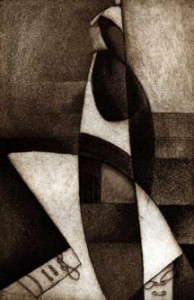
Boy in Red Cap
Joseph Holston
Etching 6″x3 15/16″
Joseph’s artworks are included in the permanent collections of the Baltimore Museum of Art; New York City’s Schomburg Center for Research in Black Culture; the Museum of Art at the Rhode Island School of Design; the Banneker-Douglass Museum, Annapolis, Maryland; the Lyndon B. Johnson Library at the University of Texas; the Hubert H. Humphrey Collection; the University of Maryland University College; the David C. Driskell Center at the University of Maryland; Howard University; the University of Vermont; the Yale University Art Gallery; DePauw University, Greedcastle, IN; the Washington County Museum of Fine Art, Hagerstown, MD; Butler Institute of American Art, Youngstown, OH; the King-Tisdell Cottage Museum, Savannah, Georgia; the AFL-CIO, Washington, DC; the Evans-Tibbs Collection; the Donald Byrd Collection; the Jean and Robert Steele Collection; and the David and Thelma Driskell Collection.
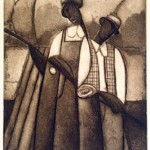
Two Fishermen
Joseph Holston
Etching 12″x9″
Some of his most significant exhibitions include the Smithsonian Institution’s Anacostia Museum, Washington, D.C.; the Arts Program Gallery, University of Maryland University College; the Washington County Museum of Fine Art; the Southern Alleghanies Museum of Art, Loretto, PA; Delaware State University; the Afro-American Museum, Philadelphia; the Butler Institute of American Art; the Fort Worth Museum of Fine Art, Texas; the University of North Carolina at Chapel Hill; North Carolina A & T State University; the APEX Museum, Atlanta, Georgia; the Visual Arts Center of Northwest Florida; and the DuSable Museum, Chicago.
Joseph has also exhibited and been a guest lecturer at DePauw University, the University of Maryland Eastern Shore, the University of Dar es Salaam, Howard University, Delaware State University, Bowling Green State University, Villa Julie College, and the Visual Arts Center of NW Florida. And, he has been artist-in-residence at North Carolina A & T State University, and at the Experimental Printmaking Institute at Lafayette College in Pennsylvania.
His commissions include North Carolina A & T State University, the AFL-CIO, the Miller Brewing Company, the National Urban Coalition, the National Medical Association, Gallo Winery, and the Washington Urban League.
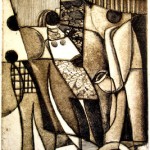
Street Corner Musician
Joseph Holston
Etching 12″x19″
Joseph likes where he is in his life, and is quick to say that “God doesn’t give him too much at one time; he gives him bits and pieces.” Currently, Joseph and his wife Sharon, who handles the business side, are preparing for their annual Open House in November. Stay tuned for information on a retrospective on Joseph’s printmaking, which is scheduled to open at the Driskell Center, University of Maryland, College Park in April 2011.
For more information contact Holston Originals at 301-460-3096 or go to http://www.holstonart.com/
Color in Freedom Virtual Tour http://www.umuc.edu/colorinfreedom/virtual_tour/index.shtml
Prospectus on touring exhibit http://www.artsandartists.org/exhibitions/colorinfreedom.html
Click below to order the 96-page full color catalog —
Color in Freedom: Journey Along the Underground Railroad
Paul Goodnight @ Gallery Serengeti
Meet the Artist – December 5, 2009 3:00 p.m. to 5:00 p.m.
December 5, 2009 to January 11, 2010
7919 Central Avenue, Capitol Heights, MD 20743
301-808-6987
Got Art? @ Design Studio Art Gallery
Opening Reception — Sunday, November 15, 2009
6:00 p.m. to 9:00 p.m.
November 8, 2009 – December 27, 2009
5702 Baltimore Avenue
Hyattsville, MD 20781
301-779-4907; 202-446-7373
• Next Issue: Paul Goodnight
